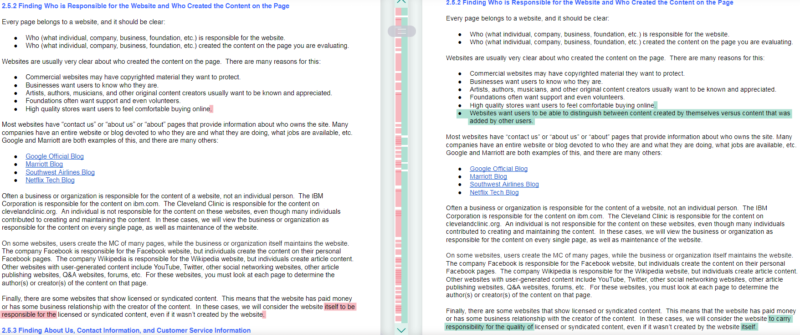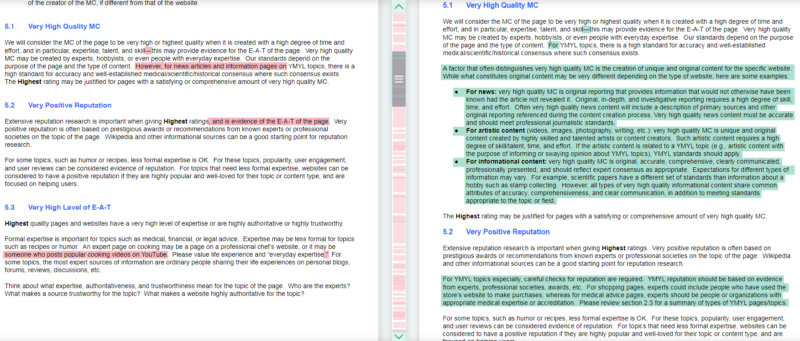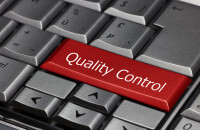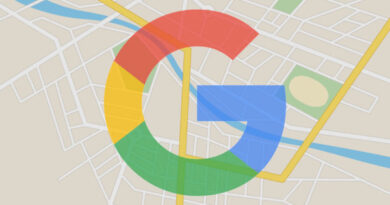Change log: Google updated its Search Quality Rater Guidelines
Here’s what’s new, compared side-by-side with the last version.
Below is an analysis of the changes. The May 16 version of the guidelines appears on the left-hand side of the screenshots, with the corresponding section of the latest version on the right-hand side.
2.3: Your Money or Your Life (YMYL) Pages

Addition of the word “topics,” broadening the content that this section may pertain to beyond web pages.
The previous “News articles or public/official Information pages Important for having an Informed citizenry” and the “Legal Information pages” sections have been reorganized and replaced with “News and current events” and “Civics, government, and law,” which now appear at the top of the list.
“News and current events” features examples of news that may not necessarily be considered YMYL. The term “voting” is explicitly mentioned in the new “Civics, government, and law” section.
“Shopping” and “Finance” are now two separate categories. “Shopping” YMYL content now includes “information about or services related to research or purchase of goods/services,” such as reviews.
“Groups of people” is also a new section; the description could be interpreted as pertaining to hate groups, solidarity groups or anything in between.
The “Other” section now also provides more examples of content that could be considered YMYL.
2.5.2 Finding Who is Responsible for the Website and Who Created the Content on the Page

This subsection of 2.5 (Understanding the Website) adds “Websites want users to be able to distinguish between content created by themselves versus content that was added by other users.” For users, being able discern between in-house and third-party content may affect the publisher’s reputation. For example, lyrics website Genius accused Google of stealing its content; only then did Google disclose that it licenses lyrics from third parties.
The final sentence of the subsection increases the responsibility borne by websites that syndicate content from just having to possess the appropriate licenses to now also potentially being held accountable for the quality of that licensed content.
2.6.1 Research on the Reputation of the Website or Creator of the Main Content

This subsection of 2.6 (Reputation of the Website or Creator of the Main Content) puts more emphasis on print media by replacing “newspaper website” with “newspaper (with an associated website).” It also allows search quality raters to take a track record of high-quality, original reporting into account — not just awards won by a publication.
4.6 Examples of High Quality Pages

The Page Quality (PQ) Rating and Explanation sections of three examples have been expanded. In line with the additions from 2.6.1 above, the news explanations now include having a positive reputation for objective reporting and investigative journalism.
Overall, the guidelines seem to be moving away from Pulitzers as the be all, end all of awards and are instructing raters to acknowledge other accolades as well.
5.0 Highest Quality Pages

Section 5.1 (Very High Quality Main Content) now expands YMYL topics outside the bounds of news articles and information pages. There are now criteria for news, artistic and informational content.
Section 5.2 (Very Positive Reputation) removes the reference to E-A-T and reminds raters to carefully check the reputation of YMYL content creators.

Section 5.3 (Very High Level of E-A-T) raises the overall bar for YMYL content, but acknowledges that standards for E-A-T will vary. It also adds video as a content source.

5.4 (Examples of Highest Quality Pages) now features two examples of high-quality news, with explanations that emphasize awards, high-quality main content, uniqueness, originality, depth and investigative journalism.

The “Highest: Entertainment” example is not present on the latest iteration of the guidelines.

The explanations for three high-quality video examples have been expanded to include uniqueness and originality.
6.7 Examples of Low Quality Pages

Four examples from this section now carry the YMYL label.
7.3 Pages That Potentially Spread Hate

“Criteria” has been removed and replaced with broader bases for applying the lowest page rating. There is also a stronger emphasis on groups.
11.0 Page Quality Rating FAQs

Google has made it more explicit to its raters that pages existing for the sake of artistic expression, humor, entertainment and the like are “all valid and valued page purposes,” and thus may not necessarily deserve a low quality rating because they do not serve more practical purposes.
12.9 Rating on Your Phone Issues

Google is no longer telling raters to assume, by default, that queries with device-specific results were issued on an Android device.
13.2.1 Examples of Fully Meets (FullyM) Result Blocks

The note once-attached to this explanation has been removed. This is in line with abandoning the assumption that device-specific results are coming from Android devices (mentioned above in 12.9).
13.5.1 Examples of Slightly Meets (SM) Result Blocks

The “ellen degeneres” example has been removed.
13.6 Fails to Meet (FailsM)

The “zoo atlanta” example has been removed.
14.6.1 Using the Upsetting-Offensive Flag

As with section 7.3, the word “criteria” has been removed, allowing for a wider bases with which to justify applying the Upsetting-Offensive flag. There is also additional emphasis on groups of people.


